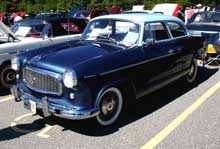How many times have we heard the familiar lament: “If only they brought back the _____, they’d sell a million of ’em.” Fill in the blank with the name of your favorite car: Model T, Model A, VW’s old Beetle and the list goes on. In reality, if they did (and could comply with environmental and safety regs) they’d probably sell a few dozen, given the speed with which technology advances. But one manufacturer did revive a dead model and make a success of it: American Motors with the Rambler American.
To be sure, the old car had been out of production less than two years, so the model was not old and stale. And as timing is everything, they were reviving an economy car in a recession, when small imports were gaining market share and the Big Three had nothing to offer in that segment. The new Rambler American was a small-change investment, since it was essentially the old Rambler that was discontinued after 1955, with a new grille and taillights turned upside down. The engine, too, was old hat, a near dupe of the 1955 flathead six with merely a new water pump location. When the powerplant was updated for the “big Rambler” in 1956 and given overhead valves, the water pump was moved from behind the generator (and driven by it) to the “conventional” spot at the front.
The Rambler, you will remember, was introduced in 1950 as a small car in the Nash line. Initially sold only as a well-optioned convertible, it was much more successful than Hudson’s Jet and Kaiser’s Henry J. A station wagon joined the ragtop that year, and later a hardtop coupe. For 1953, it was restyled with cues from the ‘52 Nash, and longer-wheelbase four-door sedans and Cross Country station wagons were brought out for 1954 (the illustrations are 1955 cars).
The revived Rambler, dubbed “American” to distinguish it from the larger models, joined the 1958 line, as a two-door sedan or station wagon, both on the short 100-inch wheelbase. Priced from $1,775, it undercut Ford by $200 and Chevy by nearly twice that much. Production for the year was modest, slightly more than 30,000, about equal to 1953. For 1959, though, sales soared to 91,491 the best year yet. In 1960, a four-door sedan was added, also on the short wheelbase, and production hit a new high of 120,603, though no match for the new compacts from Ford, Chevrolet and Plymouth. They didn’t sell a million, but 242,674 cars in three years nearly equaled the six-year total of the first Rambler.
For 1961, the American got new sheet metal, but underneath was the same Airflyte unitary understructure. A new offering was the convertible, which differed from its 1950-53 antecedent in having a fully-retractable top. With minor trim changes, the freshened American soldiered on until 1964, when a wholly-new Richard Teague design was introduced.
The car that heads this feature belongs to David Dykes of Waterford, Connecticut. I saw it, complete with authentic aftermarket swamp cooler, at the auto show put on by the Greater Norwich Area Chamber of Commerce back in September.

